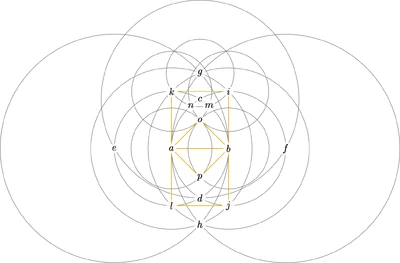The essential idea or method is always grasped intuitively long before any rational argument for the conclusion is devised. — Morris Kline
7L 7E solution
Let A and B be the given vertices.
- Construct the circle with center A and radius AB
- Construct the circle with center B and radius AB, intersecting circle A at C and D
- Construct the circle with center C and radius CD, intersecting circle A at E and circle B at F
- Construct the circle with center E and radius BE
- Construct the circle with center F and radius AF, intersecting circle E at G and H
- Construct the circle with center A and radius AG, intersecting circle B at I and J, with I on the same side as G from AB
- Construct the circle with center B and radius BG, intersecting circle A radius AB at K and L, with K on the same side as I from AB
- Point at I
- Point at K
3V solution
Starting from the 7L solution:
- Point at J
- Point at L
- Construct the circle with center G and radius GI, intersecting circle A at M and circle B at N
- Construct the circle with center K and radius KM
- Construct the circle with center I and radius IN, intersecting circle K at O
- Construct the circle with center A and radius AO
- Construct the circle with center B and radius BO, intersecting circle A radius AO at P
- Point at P
Explanation
Since there are a large number of points involved, it may be easiest to map points to a coordinate system, by using the Pythagorean theorem on right triangles. Start with A at (0,0) and B at (1,0); the midpoint between A and B would be X at (1/2,0). The first two circles at A and B have radius 1, and construct C at (1/2,√3/2) and D at (1/2,-√3/2) because ABC and ABD are equilateral triangles. Then circle C has radius √3, and constructs E at (-1,0) and F at (2,0) (CEX is a 30-60-90 right triangle; we know leg CX is √3/2 and hypotenuse CE is √3, leaving leg EX at 3/2). Circles E and F each have radius 2, and construct G at (1/2,√7/2) and H at (1/2,-√7/2) (EGX is a right triangle with hypotenuse EG 2 and leg EX 3/2, leaving GX to be √7/2). At this point, we have triangle AGX with legs 1/2 and √7/2, which makes hypotenuse AG √2. So the second circles through A and B form 45-45-90 right triangles ABI, ABJ, ABK, and ABL, putting I at (1,1), J at (1,-1), K at (0,1), and L at (0,-1) giving the points needed for the first two squares (where A and B are adjacent vertices, side length 1).
The remaining variant for the 3V solution uses A and B as opposite rather than adjacent vertices (side length √2/2). With some effort, it can be shown that the triangles AGK and KIM are similar, so the ratio AG:AK = √2:1 = IK:KM = 1:KM, so the circle at K has radius KM = √2/2, likewise for the circle at I. From there, it follows that point O lies at (1/2,1/2) at the midpoint of AI and BK, and the final two circles through A and B reflect point O over AB to point P at (1/2,-1/2).
